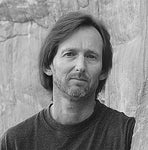Photographer James Kay (www.jameskay.com) currently serves as a professional advisor to Outdoor Photographer Magazine and his work has been featured in the Nikon Legends Collection. Known for his spectacular and personal workshops, James continues to offer the outdoor photographer a unique view into his process and examination of the landscape. His photographs have appeared in a wide variety of publications including the Los Angeles Times Magazine, Nikon World, Time Magazine, Delta Sky, National Geographic Adventure, Backpacker, Outside, Sierra, Newsweek, and Outdoor Photographer. Pictureline asked him to share his fantastic image of Utah's Cathedral of the Desert and his connection to Glen Canyon.
CATHEDRAL IN THE DESERT, UTAH
James: "Deep in a side canyon of the Escalante River in southern Utah, I captured this image of Cathedral in the Desert in April 2005 at the low-water mark of Lake Powell after five years of epic drought. The waters of Lake Powell began to flood Glen Canyon when Glen Canyon Dam was completed back in 1963. Glen Canyon was the name given to the main Colorado River canyon and its tributaries between present day Hite, Utah and Lee’s Ferry, Arizona by John Wesley Powell during his expeditions of the late 19th century. As the reservoir’s water rose, it eventually flooded all the canyons which Powell and other explorers described as the most spectacular on the Colorado Plateau.
"Beginning in the year 2000, the water level in Lake Powell began to drop due to a record low snowpack in the Rocky Mountains. By 2003, the reservoir level had dropped 100 feet, losing 50% of its volume, and I realized something amazing was happening as hundreds of miles of side canyons along Lake Powell began to emerge into the light of day. Having seen photographs of these beautiful canyons in books such as "The Place No One Knew" published as a plea to save Glen Canyon back in the early 1960s, I realized that I now might have the opportunity to see and photograph them for myself.
"So beginning in 2003, I set out on a 5-year project to explore and photograph all the re-emerged canyons surrounding the reservoir which eventually led to my book Resurrection Glen Canyon and a short film. By early spring of 2005, the reservoir had dropped to its lowest level of 145 feet below full-pool capacity, with 68% of its water gone. I knew that at this level, the legendary chamber of Cathedral in the Desert would be exposed for the first time since 1969. I outfitted an 18’ motorized raft with enough gear to spend two weeks photographing the re-emerged canyons; including Cathedral in the Desert. I used a sea kayak to access canyons which were too narrow for the raft.
"I captured this image of my wife, Susie, in her kayak at the base of the waterfall in Cathedral in the Desert as I stood on the newly-exposed sandy floor of the chamber. When the reservoir was last full in 1999, this location was 140 feet beneath the surface of the water. We spent an entire day in the depths of the canyon, photographing the scene as the light changed. With an old photograph in hand, I was able to locate the exact spot where Phillip Hyde stood to capture his iconic image back in 1964 before Cathedral was flooded. Due to an above-average snowpack the preceding winter, the water quickly rose in the following months to re-flood the chamber to the top of the waterfall. As I write this, the floor of the chamber is submerged beneath 63 feet of water, with the water level of the reservoir 78 feet below full pool."
Stay connected to James: Website | Facebook | Twitter | Workshops
RELATED ARTICLES



